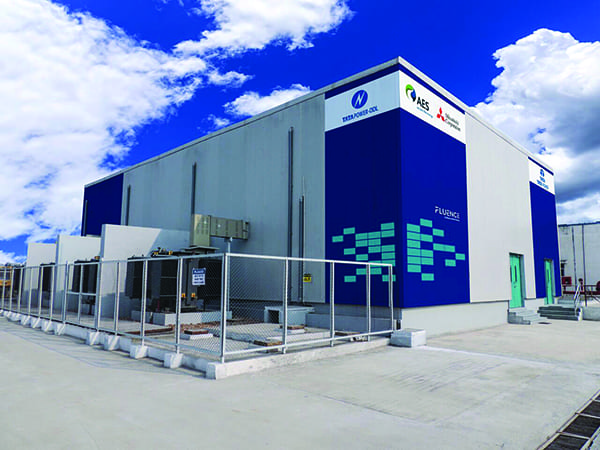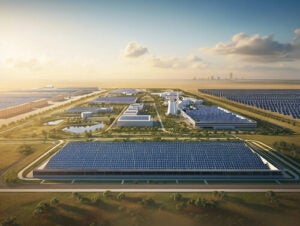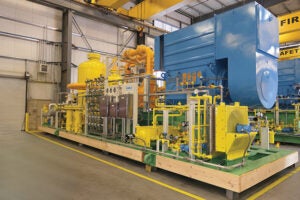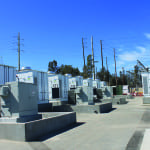India’s first grid-scale battery-based energy storage system was launched in February. The 10-MW system is owned by AES Corp. and Mitsubishi Corp., and operated by Tata Power Delhi Distribution Ltd. (Tata Power-DDL). The project (Figure 1) is located at a Rohini, Delhi, substation operated by Tata Power-DDL and designed to provide grid stabilization, better peak-load management, add system flexibility, enhance reliability, and protect critical facilities for Tata Power-DDL’s 2 million customers. Fluence, a supplier of energy storage technology jointly owned by AES and Siemens, supplied its Advancion technology for the project. Indian officials said they hope the project paves the way for wider adoption of grid-scale energy storage across the country.
 |
|
1. AES Corp. and Mitsubishi Corp. have installed a 10-MW battery storage system at a substation in Delhi, India. The system, which includes Advancion technology from Fluence, will be operated by Tata Power-DDL. Courtesy: Fluence |
“This is a market-opener project,” Manish Kumar, managing director, Energy Storage for AES, told POWER. “We believe there’s a tremendous opportunity in India for battery energy storage, for many, many projects in India. By choosing storage over alternatives, India is taking steps to modernize its energy system. We think this will allow for rapid deployment of storage across the country, integrating solar and wind, in transmission and distribution planning throughout the country.” India has a goal of installing 225 GW of renewable power generation by 2022, and officials have said battery-based energy storage can provide the flexibility needed to better integrate intermittent solar and wind energy resources into the country’s electric grid.
“Tata Power’s collaboration with AES and Mitsubishi is one of the significant milestones in the Indian power sector,” said Praveer Sinha, CEO and managing director of Tata Power, in a statement. “Grid-scale energy storage will pave the way for ancillary market services, power quality management, effective renewable integration and peak load management of Indian grids.”
Sanjay Banga, CEO of TataPower-DDL, in a statement said, “At Tata Power-DDL, we continually strive to integrate new technologies for strengthening our network to provide reliable and quality power supply to our consumers. This, India’s first grid-scale battery-based storage system, will address our key challenges in the areas of peak load management, system flexibility, frequency regulation and reliability of the network.”
Kumar told POWER: “We feel this project will pave the way for grid-scale energy storage across India. We believe battery energy storage will provide flexibility and help with integration of intermittent resources.”
Officials said battery storage systems will be a preferred method of power generation because they are fast-ramping, and can be built in a matter of months, as opposed to older technologies such as pumped hydroelectric energy storage that can take years to build and are highly dependent on geographical locations.
“One of the key advantages of battery-based storage is that it’s highly modular,” said Kumar. “Think of them as Lego blocks. They are instantaneous [no output lag at start-up], precise and accurate, generate no emissions, require no water or fuel infrastructure, so we can scale [projects]. Utility operators only need to procure the current need [for power], as opposed to a power plant, with enormous infrastructure, that you don’t know whether it will be used or not.”
Kumar said the India project is similar, but on a smaller scale, to a project AES announced in February, in which AES said it would install 100 MW of battery storage for Arizona Public Service (APS), as part of an APS plan to add as much as 850 MW of battery storage capacity at its solar power plants over the next several years.
“Battery-based energy storage has an essential role to play in helping India realize its vision for a more sustainable energy future,” said Andrés Gluski, AES president and CEO. “AES has been committed to delivering safe, reliable and affordable power in India for the last 27 years and we’re proud to bring the country’s first major grid-scale energy storage solution online and open the market for the use of battery storage technology in India.”
India in the first half of 2018 installed 4.9 GW of solar power. The government has approved plans for at least 14 new solar parks as part of its National Solar Mission, which calls for 100 GW of solar generation capacity by 2022.
—Darrell Proctor is a POWER associate editor (@DarrellProctor1, @POWERmagazine).









